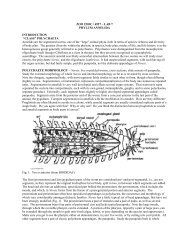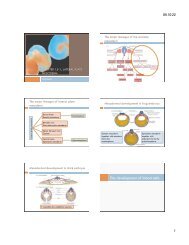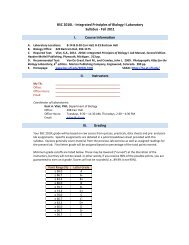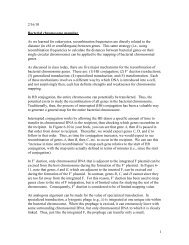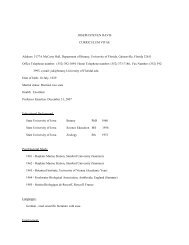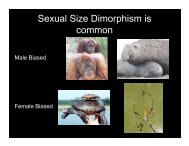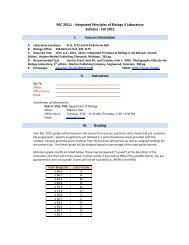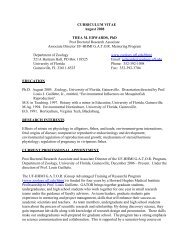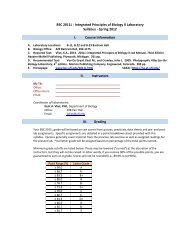You also want an ePaper? Increase the reach of your titles
YUMPU automatically turns print PDFs into web optimized ePapers that Google loves.
MOLLUSCAAplacophoraPolyplacophoraMonoplacophoraGastropodaBivalviaScaphopodaCephalopodaRostroconchia - extinctSecond largest phylum in terms of described diversity with ~100,000 described species; about twice as many aschordates.- ubiquitous, most diverse in SW, also FW, terrestrial- benthic, infaunal, planktonic, nectonic- free-living or parasitic- 1mm-15m (giant squids)Economic importance:- food: oysters (20,000 lbs/acre growable, better than cattle), scallops, clams, abalone, escargot, other snails, squid,octopus, etc.- pests: slugs and land snails - herbivores; teredinid bivalves - ship worms; disease vectors: Biomphalaria -schistosomiasisTremendous fossil record - great paleontological importance for studies on macroevolution; paleo studies alsoimportant for understanding molluscan evolution per se. ~25,000 described fossil spp., all classes w/ shellsknown since Paleozoic, all but 1 since Cambrian.Spiralian, schizocoelous protostomes, w/ trochophore larvae. Developmentally clearly linked w/ annelids,sipunculans – as the Trochozoa. Coelom reduced, mostly confined to reproductive and excretory systems,main body cavity hemocoel.No single character defines mollusks, rather a set of characters need to be used, some of which are modified orabsent in some classes (especially Aplocophora):- similar in development to annelid, but add a secondary ventral-dorsal visceral axis to existing primary ant.-post.somatic axis. However this is secondary within phylum: ~absent in Aplacophora and limited inPolyplacophora, but well developed in Conchifera.- regionated body: head, foot, visceral mass, covered by mantle, shellAxis Organ system <strong>Major</strong> mechanism <strong>Major</strong> functionPrimary (somatic) Head, foot Muscular Locomotion, feedingSecondary (visceral) Visceral mass, mantle, shell Ciliary Resp., dig., repr.Will describe basic body plan of a basal conchiferan - "HAM" - note this is good background to most mollusks buttwo classes (Aplocophora, Polyplacophora) precede conchiferan lineage & morphology, and differ in manyaspects (especially Aplocophora).Body wall: covered by cuticle, epidermis w/ lots of mucus glands, very thick connective tissue developed all overbody, permeated by sinuses containing fluid - hemocoel.Mantle: body wall flap, secretes shell; mantle cavity: site of respiration with lateral / posterior ctenidia, posterioranus, but moves anteriorad in gastropods due to torsion. Ciliary currents in mantle cavity: separation of in- andexcurrent flows, for gills & to carry wastes; cilia do all moving, mucus for cleaning again w/ cilia.
Ctenidia: specialized molluscan gill. Not clearly homologous through whole phylum. Movement of water bylateral cilia between gill flaps, blood circulation - counter-current exchange.Shell: primitively calcareous spicules only – Aplacophora. Shell may be diphyletic: Polyplacophora andConchifera (Scheltema 1988). Conchifera: periostracum & shell layers. Periostracum - outer organic layer -derived from cuticle? Several (usually 2-3) shell layers, each with typically different skeletal microstructure.Nature of microstructure depends on protein matrix scaffold over which CaCO 3 is precipitated. Aragoniteor/and calcite. Plesiomorphic outer – inner shell layers thought to be prismatic – nacreous. Myostracum =muscle attachment layer; always aragonitic.- secreted by mantle - 3 mantle lobes at mantle margin, periostracum originates between 1 st and 2 nd . 2 nd lobesensory – often w/ sensory extensions, 3 rd muscular – controls water flow in and out of mantle cavity.Dig.: Radula: belt w/ chitinous teeth, some hardened w/ Si or magnetite (chitons), w/ odontophore (cartilaginousbase) and lots of muscles. Made in radular sac then worn off at other end. Various numbers of teeth per row,depends on group. Protrude, radula can slide over odontophore, teeth become erect (folded in mouth), scrape,or just close teeth - back in. Radula present in earliest molluscs, lost in bivalves. Primitive radula may havebeen double belt w/ 1 tooth on each. Jaws: in many mollusks, usually lateral pair (but vertical beak incephalopods), for biting.Salivary glands secrete mucus and, seldom, enzymes. Esophageal glands secrete digestive enzymes. Esophagusinto stomach; latter w/ wide anterior portion w/ chitinous shield, into which digestive glands and posteriorstyle sac open. Extracellular digestion in stomach, intracellular digestion in digestive glands. Style sac makesprotostyle = mucus strand & food rotated by cilia toward intestine - found in macrophagous species w/ somedigestion in stomach, some in digestive glands. Crystalline style (especially in bivalves) in microphagousspecies w/ intracellular digestion - these as a rule lack esophageal glands, digestion in digestive glands.Crystalline style made of compacted mucus plus enzymes, breaks up and releases enzymes as it mixes w/ food.Intestine: site of fecal pellet fm. Anus at posterior end of mantle cavity; need well-compacted fecal pellets notto soil mantle.Nerv.: Primitively amphineurous, i.e. lack ganglionation - in aplacophorans, chitons, monoplacophorans: circumesophagealring & paired pedal and pallio-visceral cords innervating foot and viscera respectively. Laterganglionation on these cords yields cerebral, pedal, visceral, ganglia; additional ganglia (pallial, etc) may alsobe present. Commissures, connectives.Sens.: tentacles common, sensory elaborations on head & also at mantle edge. Osphradia: sensory epithelia inmantle cavity near gill to test incoming water - chemoreceptive & sense sediment load - shut gills down if toomuch fouling. Eyes developed to varying degrees from none to simple pigment cups (on tentacles or mantlemargin) to image-forming cephalopod eyes.Circ.-Coel.-Excr.: Circ. system open, contiguous w/ hemocoel. Gill to auricle (usually 2, 4 in monoplac., 1 incaenogastropods) to ventricle (1, prd. in monoplac.) to body. Most w/ hemocyanin, some hemoglobin.Coelom greatly reduced: pericardium. Pericardium largest in basal classes (Aplocophora, Polyplacophora,Monoplacophora); single in most, but paired in Monoplacophora. Filtration through peritoneal podocytessurrounding ventricle; also pericardial glands secrete wastes into coelom. Kidneys elaborated on nephridialducts, can be bulky structure not just a duct; duct opens in mantle cavity. Further waste secretion &modification in nephridium.Repr.: Gonads elaborated from pericardial peritoneum; gametes dumped through nephridioduct. Separategonoducts in chitons; in monoplacophorans gonoducts open into nephridia.Dev.: Typical spiral cleavage, 4d, schizocoely, trochophore larva, protostomy. Veliger larvae - in bivalves,scaphopods & gastropods - w/ shell, foot. Direct development in several, especially cephalopods.Evol/phylog.: Two alternate hypotheses: Aplacophora(Polyplacophora(Conchifera)) or (Aplacophora-Polyplacophora)(Conchifera). Aplocophora-Polyplacophora = Aculifera (spicule bearers). New data fromGiribet et al (2006) however suggests Monoplacophora-Polyplacophora to be sister = “Serialia”, withreasonable robustness, though overall their tree is more lawn then tree and not satisfying.
POLYPLACOPHORALate Cambrian – Recent for “normal” chitons. Some early chitons really wonky – also some very odd mollusks ofintermediate aplocophoran-chiton grade in early Paleozoic. Achaenoplax – bizarre Silurian “wormiformmollusk” with 18 dorsal ridges, 7 dorsal and 1 ventral valve and spines. Several genera of Multiplacophora(Dev-Permian; considered an order within the class, but sister to typical chitons – Vendrasco et al 2004) have 7rows of plates, but except for endplates; rest composed of series of 3 plates in a row (17 plates total). So likely7 plates ancestral in chitons (also reflected in development).Sutton et al. 2001 Nature 410: 461 (left); Vendrasco et al. 2004 Nature 429:288 (right)~750 recent spp., all marine.Uniform body plan - mainly live on hard bottoms in shallow water (but to 3000m). Visceral mass depressed, headreduced, foot flat, broad, elongate, shell - 8 'valves' / 'plates'.Shell: Unusual, may have evolved independently from other molluscan shells. 8 valves allow for flexibility (manycan roll into ball) and strength. Aragonitic. Layers:1) periostracum;2) tegmentum = exposed portion of valves; CaCO 3 , soft, sculptured, pigmented, perforated by sensory structures(aesthetes – sensory and secretory, photoreceptors w/ lenses, in old ones tend to get occluded); lost inCryptochiton;3) articulamentum - extends under valve in front, usually thickest layer, strong, crossed-lamellar microstr.4) hypostracum - secreted by diff. mantle regions; 3&4 extends forward to form valve articulation.
Girdle: Mantle proliferation lateral to tegmentum, over articulomentum.. Highly variable among species, w/bristles, scales, granules, hairs (some innervated), CaCO 3 spines (secreted extracellularly as in Aplocophora)Mantle cavity: All around head & foot, w/ 4-40 prs. of ctenidia, water in from anterior and lateral, exitposteriorly.Dig.: Subradular organ tests substrate before feeding. Radula 17 teeth per row, often strengthened by addition ofhematite. Most extracellular digestion, dig. gland to esophagus; stomach. Intestine: fecal pellet fm. Mostherbivorous grazers, however often w/ large portion of sessile fauna in diet; Placiphorella as trappingcarnivore.Coelom &c: pericardium & paired kidneys w/ ducts & own prd. pore; single, central, fused gonad w/ paired,separate gonoducts and lateral gonopores opening in pallial groove and independent of pericardium. 1ventricle, paired auricles.Nerv.: amphineurous: i.e. lacks ganglionation & has pedal & pallio-visceral cords. Sense: aesthestes function?,eye.Repr.: Most dioceous, but Lepidochitona (~6 spp.), 2 spp. are hermaphroditic & selfing (very little male gonad asneed little). Some brood in mantle cavity.Dev.: All lecithotrophic, trochophore, add shell regions sequentially, 7 appears most clearly first but even theseappears to be sequential.MONOPLACOPHORAEarliest Cambrian to Mid-Devonian (350 Ma) until 1957. Proposed separate by Wenz 1938, Knight 1952 on basisof fossils based on multiple (5-8) muscle scars suggesting segmented bug. Neopilina galathea Lemche &Wingstrand 1957, collected in 1952, deep sea. Also Vema, shelf edge, canyons in CA. Now 30+ spp. Livingspp. lack muscle scars.Basal Conchifera or chiton sister? See Giribet et al. 2006.Metamerism: 5-6 pr. gills; 2 pr. auricles; 6 pr. nephridia; 2 pr. gonad; 8 pr. foot retractor muscles (this also inchitons & Babinka & may be primitive?); 10 prs. of nervous connectives between cords.Shell: limpet-like, flat, overhanging head. Fossils many w/ more elaborately coiled planispiral, etc. shells.
Mantle cavity: Groove around entire animal - head & foot, post. anus, w/ 5-6 pairs of gills ?if homologous w/ctenidia. Foot circular, muscular periphery, anterior mucus groove.Circ.: 2 pairs of auricles, paired ventricle (?unique), blood from gills to nephridia then auricles.Excr./coelom/repr.: Prd., relatively large pericardial coelom. 6 prs. of nephridia, all w/ ducts to outside; posterior5 also w/ ducts to coelom; 3rd and 4th also w/ an additional duct to 2 pairs of gonads. Nephridiopores openinto pallial groove.Dig.: Large radula, stomach w/ crystalline style, digestive glands.Nerv.: cf. chiton, amphineurous, w/ 10 prs. of connectives between visceral and pedal nerve cord.Largest class, >75,000 species; all habitatsMollusks with torsion.GASTROPODATorsion- in veliger, phase 1 rapid, due to contraction of left foot retractor muscle causes counterclockwise rotation ofvisceral mass by 90 o , followed by phase 2 slower due to differential growth to complete to 180 o- results: mantle cavity becomes anterior, looped gut, twist in nervous system – see diagram- euthyneural to streptoneural: i.e. twisted nerves- why? not sure. Thorson – protect head of veliger; lots of other hypotheses- problems: sanitary – anus, nephridia etc open over head- detorsion – in opisthobranchsCoiling & shell diversity- coiling different from torsion- twist in coiling in most/all living gastropods, secondary symmetry in many though- dextral / sinistral; predominance of former in prosobranchs; pulmonates more evenLogarithmic spiral- 3 components to determine shell shape:- aperture defines shape of generating curve- expansion rate (W) = how fast widens- translation rate (T) = how fast moves down on axis of coiling- + potential final modifications if determinate growthDriving force1) escalation w/ durophagous predators- shell thickness- shell microstructure- aperture constriction- apertural armature- thickened aperture- determinate growth- episodic growth2) room inside shell- shape of shell- resorption of internal whorls3) facility of calcification- latitude, depth, temperature, salinity, soil conditions- periostracum to protect shell4) locomotion- weight of shell; not issue with sessiles (vermetids, etc)
- streamlining for burrowing forms- limitation for fast movers (cf. pagurids vs. diogenids), strombids - Terebellum- reduction for pelagic formsContinuous growth – mostEpisodic growth – e.g. many muricids - varicesDeterminate growth – e.g. cowries- record of all growth preserved in shellMantle evolution in gastropods- major changes in mantle in gastropods, largely related to torsion and coiling- L gonad lost in all extant gastropods- reduce and loose R gill and auricle, then half of gill lamellae- loose one kidney- reduce and loose L shell adductorCharacter Pre-gastropod condition Archaeos Caenosgills 2 L&R or L L onlygill pectinae bipectinate Bipectinate monopectinateauricles 2 L&R or L L onlykidneys 2 L&R (patellos) or L or R (neritoids) L onlygonads 2 R only R onlyshell muscles 2 L&R or R R onlyBasal gastropods – “archaeogastropods” – include Vetigastropoda and Docoglossa (Patellogastropoda) – freespawners, no egg capsules, many with trochophore larvae (only gastropods with such), most are grazers.High gastropods = Caenogastropoda & Heterobranchia. Evolve internal fertilization, egg capsules – elaboratereproductive plumbing to go with it. Now includes opisthobranchs and pulmonates. Basal members lacksiphonal canal, but higher members possess it.Heterobranchia = some prosobranch groups (architectonicids, pyramidellids, etc.) plus opisthobranchs andpulmonates.Gastropoda – major groups:Current classificationSuperorder PatellogastropodaSuperorder CocculiniformiaSuperorder “Neomphaloida”Superorder VetigastropodaSuperorder NeritopsinaSuperorder CaenogastropodaSuperorder Heterobranchia“Basal heterobranchs”OpisthobranchiaPulmonataOld classificationClass Prosobranchia – Order ArchaeogastropodaClass Prosobranchia – Order ArchaeogastropodaClass Prosobranchia – Order ArchaeogastropodaClass Prosobranchia – Order ArchaeogastropodaClass Prosobranchia – Order ArchaeogastropodaClass Prosobranchia – Order Mesogastropods & NeogastropodaClass Prosobranchia – Order MesogastropodaClass OpisthobranchiaClass PulmonataPatellogastropoda – all members are limpets, though limpet shaped evolved in numerous other lineages ofgastropods. Most members IT, where they dominate limpetdom (in IT only siphonariids not patellos). Grazingherbivores; strong zonation; highest div in temperate macrotidal zones w/ abundant hard substrata – NEP,SAussi, SAfr. Some lineages with single ctenidium (lottiids, acmaeids), some gill-less (lepetids), some w/secondary gills (patellids, nacellids)Vetigastropoda – top shells and relatives; includes abalones, and other abalone-form shells (among trochids –stomatellids). One or two gills, grazing herbivores. Unusual adaptations for water flow in shell when two gills,i.e. when can’t go just left to right in mantle: slits and holes in shell. Rhipidoglossate, has epipodium andepipodial sense organs (esp. tentacles). Trochoids w/ 1 gill.
Neritopsina – tropical and deep sea group, nerites and relatives. Displacement from main subtidal environments toIT, caves, deep sea, FW, land. Includes intertidal Nerita – dominant rocky IT snails in tropics – w/ inner whorlshell resorbtion as key adaptation: allows more room, especially for holding onto water.CAENOGASTROPODALittorinidae – intertidal grazers worldwideCalyptroidea – build mucus filter in mantle cavity and filter; juveniles graze but switch as adults. Crepidula,Calyptraea, TrichotropisVermetidae – worm snails – filter feeders with large mucus strands passed out of shell – feed on particles caught.Spermatophores to pass gametes among animalsNaticidae – moon snails – soft bottom animals, burrow well, drill shells, mainly clams. Have accessory boringorgan, alternate it with radula – which secretes carbonic anhydrase, softening shell.Cypraeidae – start in bulla stage, have determinate growth with distinct adult stage. Mantle over shell – henceshine.Tonnoidea – diverse, carnivorous snails, resemble Neogastropoda in having siphonal canal. Fusitriton secretesH 2 SO 4 – makes spines of urchin fall off when spit on them. Charonia tritonis feeds on stars, includingAcanthaster. Many with episodic growth – ranellids, bursids; or determinate growth: cassidsNeogastropoda - ~good cladeBuccinoidea – diverse predators and scavengers, especially diverse at high latitudes and continental shores.Buccinum, Busycon, MelongenaMuricoidea – drilling predators, live on hard bottoms – feed on snails, barnacles, also eat worms. Many withepisodic growth – e.g. Murex, Cerathostoma, Nucella, OecenebraConoidea – predators – tend to loose all but 1 tooth, predators on worms, mollusks, fish. Internal shell resorption inConus. TurridaeHETEROBRANCHIALower heterobranchs: architectonicids, pyramidellids, etc. Do any have gills?PulmonataOf marine ancestry, most primitive spp. marine (all intertidal), however majority on land or FW. Successful -~25,000 spp.Gills absent, mantle cavity converted into gas-exchange organ, heavily vascularized. Mantle cavity sealed exceptfor pneumostome, ventillation facilitated by arching of body (mantle cavity floor). Most FW also breath air(hold breath), though some secondarily fill lung w/ water for resp.No operculum (except in Amphibola - marine), shell often thin as CaCO 3 limited, well developed periostracum.Shell lost in several lineages.Generally hermaphroditic.Systellommatophora - onchidiids, veronicellidsBasommatophora - Siphonaria & friends, elobiids, otherwise FW, include FW limpets; 1 pr. of tentacles w/ eyes atbase.Stylommatophora - entirely terrestrial! Land snails and land slugs. 2 prs. of tentaclesOpisthobranchiaNumerous groups; tendency for loss of shell in several. Fully shelled to reduced, internal shell, to shell-less.Cephalaspidea – shield-shaped head, shell well formed in some, small, internalized in others, lost in some. Closeto original opisthobranch stock. Primitively soft-bottom, burrowing animals. Feed on detritus, some evolvedherbivory, and some are carnivorous, including on other cephalaspids.Actenonoidea – usually now separated from cephalaspids; may be basal (Mikkelsen) or not (Vonnemann et al.2005). Well-developed shells.Saccoglossa – sucking slugs; w/ or w/o shell. Chloroplast retention in many. Acquisition of algal genes into snailnucleus in most advanced case.
Acochlidoidea – mostly interstitial, plus FW – only opistho clade in FWPteropods – Thecosomata (shelled) and Gymnosomata (naked) – major pelagic radiation of opisthobranchs. Footbecomes parapodia only, used for flapping swimming. Abundant in plankton often, include several feedingstrategies – filter feeders and carnivores.Anaspidea – sea hares – herbivores. With rolled rhinophores, enrolled oral tentacles, parapodia. Shell bubble(Akera – previously cephalaspid) to internal sliver, to lost. Ink. 2-70 cm. Derived from paraphyleticcephalaspids (Dayrat & Tillier 2002 – detailed morph phylog)- “Two characters common to both the Akeroidea and the Aplysioidea are the presence in the mantle cavity of anopaline gland (which secretes a colourless smelly fluid) on the floor and the purple gland on the roof (whichproduces a red or purple coloured ink). A third common feature is the oesophageal gizzard which contains ananterior chamber with large chitinous plates, and a posterior chamber with numerous fine spines. Allanaspideans are 'herbivorous', feeding on specific algae or cyanobacteria.” – Rudman SSFNotaspidea/Pleurobranchoidea – (sans tylodinids) – gill on right side of body, rolled rhinophores, reduced or noshells, mostly tropical. Food – sponges, ascidians, cnidarians. Coming out as sister to nudibranchs fairlyrobustly, which is nice with given they their food and virtual/complete shelllessness (Vonnemann et al. 2005).Tylodinoidea – now coming our separate. Well developed, limpet-like shells, feed on sponges. Becerro et al.(2003) show that at least the species they studied really feeds on the cyanobacterial symbionts of their sponge,not on sponge tissue per se!Nudibranchia – most diverse group of opisthobranchs by far; no mantle cavity, rhinophores (novel tentacles ondorsum, not head), shell-less, novel gills in some. Mostly predatory on sessile prey, especially on sponges,cnidarians, and bryozoans. Gaudy colors due to chemical protection. Start out as shelled veligers – in neatgelatinous egg masses – then shed shell at metamorphosis.- Aeolidina – cerrata; generally cnid feeders, klepto-nematocysty, Doridina – anal gills (in most), sponge, bryozfeeders (most; some barnacles, etc), Arminina, DendronotinaSubclass Protobranchia = PaleotaxodontaSubclass LamellibranchiaPteriomorphaOrder PterioidaUnio-TrigOrder TrigonidaOrder UnionidaHeteroconchaOrder VeneroidaOrder MyoidaOrder AnomalodesmataBIVALVIA~10,000 species, largely marine but also common in fresh water (several indep. invasions). Free living, fewcommensal, Barnes lists an Entovalva that lives in sea cuce gut (p. 433). Many infaunal (some boring in rockor wood) or epifaunal - can be free living, loosely attached w/ byssus or cemented, scallops can swim.Headless, radula-less, no fancy sense organs. 2 lateral shells, in most entire animal is enclosed within. Spaciousmantle cavity created by mantle lobes that make shell. Foot large or small, ventral, ax-like, not flat(pelecypod), viscera fill shell dorsal to foot.Evolved from Rostroconchs (Runnegar & Pojeta 1985) - which had folded shell. Rostroconchs in turn evolvedfrom Monoplacophora. Earliest record: Early Cambrian (Pojetaia & Fordilla). Tremendous fossil record - cantell a lot about bivalves from shell.
Shell: 2 valves, originated from medial thinning out of ancestral single shell. Critical event of origin: ligamentbetween separated shells. Bivalve ligament primitively of 3 layers, periostracum, unmineralized tensionallayer, mineralized compressional layer; latter always of aragonite & prismatic. Prismatic fibers of uniformshape through group, added onto by growth at their ends.Shells articulate by hinge - teeth - to prevent lateral displacement (taxodont, heterodont, cryptodont etc.); connectedby ligament - organic structure, at least in part homologous to shell and evolutionarily derived from it. Outerlamellar and inner fibrous (aragonitic) ligament, former - tension, latter - compression (&poor under tension).(Lamellar lig. may be homologue of periostracum or outer shell layer dep. on whose hyp.; fibrous always shellhomologue). Resilin - rubber like protein. 2 major types: external C spring ligament, stronger, under bothcompression and tension; vs. internal resilium, under compression.Ligament opens valves; may be supplemented by foot also though; valves closed by adductor muscle(s) - 1 or 2.Opening much weaker – cf mouth in us, gators.Mantle: Spacious cavity, secretes shell, hinge teeth, ligament, entirely encloses animal. 3 lobed mantle edge: outersecretes shell, periostracum folded in between outer and middle. Middle - sensory, inner - muscular, most ofteninvolved in fusion. Mantle margins originally separate but have become secondarily fused in a variety ofbivalve groups, such fusion is largely to separate incurrent and excurrent water flows. Primitively incurrentwas anterior and ventral, excurrent posterior; tendency for incurrent to move to posterior also throughevolution. In many inner or inner and middle mantle folds proliferate and fuse to form siphons, these may beseparate or fused together, may have 1 or 2. Pallial muscle attached to shell a bit back - may have infold: pallialsinus.Muscle scars in shells - adductor muscle - to close shell, primitively 2 (anterior and posterior); anterior tends to bereduced and lost in some groups coincident w/ a decrease of the anterior end of the shell. Pedal retractormuscles often 2 pairs, may be more - to pull foot in; pallial muscle attaches mantle to shell - somewhat in fromedge. In bivalves w/ well developed siphons - pallial sinus to accomodate them, from its depth can tell depth ofburrowing - paleoecology.Feeding: Dep. on class: Most protobranchs are deposit feeders using palps and palp proboscides. Ctenidia usedonly in respiration, simple in structure. Lamellibranchs use gill for filter feeding: folded on itself. Filibranch= gill filaments attached to each other only by ciliary clumps (Pterioida, Trigonida); eulamellibranch = gillfilaments attached to each other by tissue junctions both between filaments and between lamellae (rest).Ciliation of gill filament: laterals create water current, laterofrontals may or may not intercept food(controversial), frontals carry it to food grooves at fold.Some lamellibranchs - secondary deposit feeding - many Tellinacea - use elongate separate siphons as vacuumcleaners. Septibranchs: lost their gill, have muscular septum, muscular siphon - feed on small crustaceans etc..Chemosymbiotic bivalves - Lucinidae, Solemyidae, some vent fauna (Calyptogena magnifica) - farmchemosymbiotic bacteria in gill. Tridacnines - giant clams - have photosymbionts (zooxanthellae) in mantle,grow to enormous sizes (1+ m); some other bivalves also photosymbiotic (some cardiids). Some wood boringbivalves (teredinids) may also feed on wood.Digestion: Stomach w/ crystalline style: transparent rod of enzymes and mucus, winds in the mucus mass of food,grinds food against gastric shield liberating enzymes in the process.Foot: Muscular, used for burrowing if infaunal: extend, expand as anchor, contract to pull shell down; wedge shellopen to anchor shell while push foot down again. In epifaunal species - foot usually degenerate, though oftenretaining byssus generating role. Byssus (only in lamellibranchs), secreted by byssal gland, solidifies as byssalthread (in byssal groove) attached at 1 end to substrate, at other to bivalve. Generally present in most juveniles- even in infaunal species to anchor juvenile to sand grains; also in some adults - especially common inPterioida. Can release byssus - move away and lay down new ones. Mussels move around using it. Scallopsoften attached byssally, release to swim off. Foot in byssates species extensible organ. If cemented bivalve -loose byssus.
Circ.: Lack blood pigment in most - as have large gills and low metabolic rates. However hemoglobin in Arcidae– blood cockles.Nerv./sens.: In mollusks in general photoreceptors on head microvillar elsewhere on body ciliary & thus all bivalvephotoreceptors ciliary (cf.scallop eyes).Repr.: Most dioceous, free spawning. Dwarf males in few. Gametes out via nephridia in protobranchs, viaspecialized gonoducts.Development: Trochophore larva first, then test-cell larva in protobranchs (shell developing internally); veligers inlamellibranchs - always w/ 2 shells dev. as 2 areas of calcification. Glottidia larva of many unionids - parasiticon fish. Metamorphosis: shed velum.Diversity: see FHL lecture notes.Iso – hetero – mono-myarianByssate, endobyssate, cementedSubclass NautiloideaSubclass ColeoideaOrder SepioideaOrder TeuthoideaSuborder Myopsida (loliginids etc)Suborder OegopsidaOrder VampyromorphaOrder OctopodaSuborder CirrataSuborder IncirrataCEPHALOPODAVampiroteuthis video: http://www.youtube.com/watch?v=q5ZQH2Uzpew&feature=related~700 living, >10K fossil species; U Cambrian-RecentAll marine; pelagic radiation, all carnivorous/scavengers, some mostly benthic now; major radiation in deep sea,bathypelagic and deep benthic alsoMedium-large: 2 cm – 20 mCephalopods are mollusks that have shells with chambers and siphuncle; allows gas secretion thus buoyancy withshell. Nautilus modern model.Evolutionary history: gradual reduction and, in some, loss of shell.Body plan- elongation along visceral (secondary) molluscan axis: cephalopodium – visceropallium- thus head ventral, tip of body dorsal- viscera enclosed in shell, or in muscularized mantle- foot turns into funnel- arms developed around mouth – outgrowths of head; numerous in Nautilus, 8-10 in coleoids with suckers (andhooks in some)- ink sac – escape; some deep with bioluminescent inkShell- primitively external, chambered, with siphuncle – key innovation on molluscan shell allowing invasion of pelagicrealm- complex evolutionary history; major variation through fossil record in coiling, emphases on different parts ofshell, etc- in living cephs Nautilus w/ plesiomorphic shell, and the only species with proper external shell
- rest with internalized shells: sepioids and Spirula retaining calcareous shell, shell reduced to chitinous pen insquids, lost altogether in vampiromorphs and octopods- egg-case shell: ArgonautaFast living- live fast and die- fast movement, rapid swimming with jet propulsion, backwards; or with fins (or jetting) forward as well- funnel provides propulsive force in Nautilus; it directs force from muscular mantle in others- live for moment, don’t save – little energy reserves: very little lipid, some glycogen, mostly muscle- rapid life cycles, especially given size- most species semelparous, including malesCirc- closed, lined, with high blood pressure – convergent with vertebrates.Dig- large, chitinous “parrot” beaks – powerful biting organ- venom gland (modified salivary gland) – can kill humans in some species- radula: rasps up what has been eaten; can bore into shells in octopus- carnivorous: fishes, other cephs, other mollusks, crustaceans- esophagous goes through cartilaginous brain case, limits size of food particles swallowed- stomach and caecumNerv-Sens- highly centralized nervous system, with large brain enclosed in cartilage and surrounding the esophagous(centralization with circumesophageal connectives becoming incorporated into brain??)- chromatophores under nervous control: complex communication and behavior- pinhole eyes in Nautilus; others with lens and cornea, or exposed lens. Best eyes as good as vert, and as retina isnerved from behind – more sensible.- “the only cephalopod known so far to have color vision is the firefly squid (Watasenia scintillans)”http://www.thecephalopodpage.org/cephschool/CephalopodVision.pdfRepr- internal fertilization, spermatophores- hectocotylus- large, yolky eggs, modified development, paralarvae- benthic egg masses, tended in octopods- ArgonautaNautilus body plan- shell: chambered, siphuncle, body in last chamber, older chambers filled with gas- hood acts as operculum- funnel furled, not fused. Peristaltic motion of funnel for jet propulsion as not muscular body- 2 pairs of ctenidia- many arms, lacks suckers





